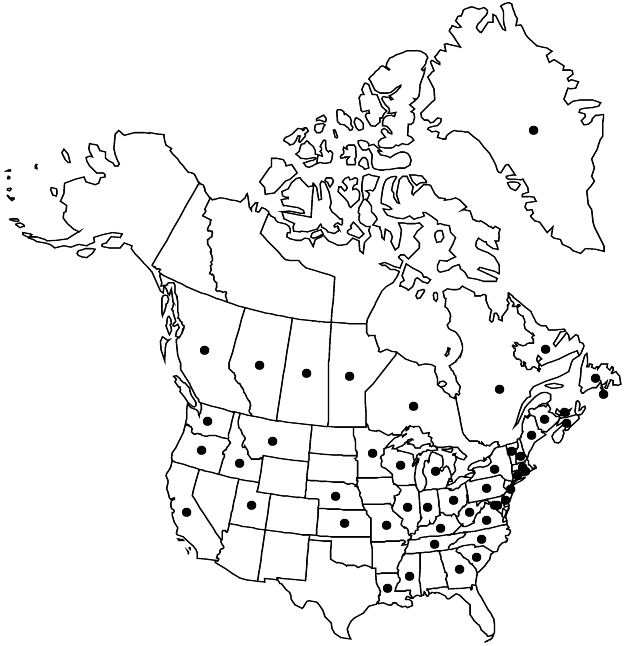Viola arvensis
Prodr. Stirp. Gott., 73. 1770.
Plants annual, caulescent, not stoloniferous, 5–35 cm. Stems 1–5, usually erect, sometimes prostrate or decumbent, branched, subglabrous or puberulent, clustered on taproot. Leaves cauline; stipules palmately lobed, middle lobe oblanceolate, obovate, elliptic, or lanceolate, ± equaling leaf blade, proximal lobes dissected, shorter, margins ciliate, apex acute to obtuse; petiole 0.5–2.3 cm, glabrous or puberulent; blade: proximal ovate to ± oblong, distal narrowly or broadly lanceolate, 0.8–3.4 × 0.3–1.9 cm, base attenuate to ± truncate, margins coarsely crenate-serrate, ciliate or eciliate, apex acute to obtuse, surfaces pubescent abaxially, at least on major veins, glabrous adaxially. Peduncles 2–8 cm, glabrous or pubescent. Flowers: sepals lanceolate, margins ciliate or eciliate, auricles 2–4 mm; petals white to pale yellow on both surfaces, upper 2 ± violet, lower 3 with yellow basal area, often violet-veined, lateral 2 bearded, ± equaling or shorter than sepals, lowest with dark yellow area basally, 7–15 mm, spur blue-violet to purple, elongated, 3–5 mm; style head bearded; cleistogamous flowers absent. Capsules ± spherical, 5–9 mm, glabrous. Seeds brown, 1.5–1.9 mm. 2n = 34.
Phenology: Flowering May–Jul.
Habitat: Abandoned fields, roadsides, lawns
Elevation: 0–3000 m
Distribution

Greenland, St. Pierre and Miquelon, Alta., B.C., Man., N.B., Nfld. and Labr., N.S., Ont., P.E.I., Que., Sask., Calif., Conn., Del., D.C., Ga., Idaho, Ill., Ind., Kans., Ky., La., Maine, Md., Mass., Mich., Minn., Miss., Mo., Mont., Nebr., N.H., N.J., N.Y., N.C., Ohio, Oreg., Pa., R.I., S.C., Tenn., Utah, Vt., Va., Wash., W.Va., Wis., Europe, Asia (Siberia), Africa.
Discussion
A. R. Clapham et al. (1987) noted that Viola arvensis is pollinated by insects and is often selfed; T. Marcussen and T. Karlsson (2010) stated that V. arvensis regularly self-pollinates. Roots of V. arvensis have the odor of wintergreen when crushed (A. E. Radford et al. 1968; W. J. Hayden and J. Clough 1990). Viola arvensis is not vegetatively distinguishable from V. tricolor var. tricolor.
G. Halliday (pers. comm.) reported that Viola arvensis occurs in southwestern Greenland, where it is introduced, and is ephemeral on St. Pierre and Miquelon.
Selected References
None.